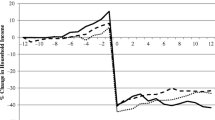Abstract
Do welfare reform policies affect marital stability among two-parent families? Long term findings from an experiment in Minnesota, evaluated via a random assignment design, contribute to the little evidence to date about whether or not welfare and income-support policies can affect marital stability. In 1994, Minnesota began to test a major welfare reform initiative that emphasized financial incentives for work, a participation requirement for long-term recipients, and the simplification of rules and procedures for receiving public assistance. An analysis of this program's long-run effects on marital stability for two-parent families finds no effect overall but contrasting effects for several subgroups. MFIP particularly lowered the rate of divorce among families who were already receiving welfare when they entered the study. There are less consistent effects among new applicants to MFIP – who show a trend toward higher rates of divorce relative to the control group.
Similar content being viewed by others
References
Acs, G. & S. Nelson (2004), Changes in living arrangements during the late 1990s: Do welfare policies matter? Journal of Policy Analysis and Management 23(2): 273–290.
Becker, G.S. (1973), A theory of marriage: Part I. Journal of Political Economy 81: 813–46.
Becker, G.S. (1974), A theory of marriage: Part II. Journal of Political Economy 82: 511–26.
Bitler, M., Gelbach, J.B., Hoynes, H.W. & Zavodny, M. (2004), The impact of welfare reform on marriage and divorce. Demography 41(2): 213–36.
Cain, G.G. & Wissoker, D. (1990), A reanalysis of marital stability in the Seattle– Denver income-maintenance experiment. American Journal of Sociology 95(5): 1235–1269.
Conger, R., Ebert-Wallace, L., Sun, Y., Simons, R., McLoyd, V. & Brody, G. (2002), Economic pressure in African–American families: A replication and extension of the family stress model. Developmental Psychology 38(2): 179–93.
Conger, R.D., Reuter, M.A. & Elder, G.H., Jr. (1999), Couple resilience to economic pressure. Journal of Personality and Social Psychology. 76(1): 54–71.
Edin, K. (1999), What do low-income single mothers say about marriage? Mimeo.
Edin, K. (2000), Few good men: Why poor women don't remarry. The American Prospect 11 (4).
Ellwood, D. (2000), The impact of the earned income tax credit and social policy reforms on work, marriage, and living arrangements. National Tax Journal 53: 1063–1105.
Fein, D. (2003), The determinants of marriage and cohabitation among disadvantaged Americans: Two themes from a literature review. Conference paper. Marriage and Family Formation among Low-Income Couples: What do we know from Research? Georgetown University, Washington, DC, September, 2003.
Fein, D., London, R.A. & Mauldon, J. (2002), Welfare reform and family formation: Assessing the effects. A research brief from the Welfare Reform and Family Formation Project, Bethesda, MD: Apt Associates. www.abtassociates.com/wrffproject.
Fitzgerald, J.M. & Ribar, D. (2004). Welfare reform and female headship. Demography 41(2): 189–212.
Fraker, T., Ross, C. A., Stapulonis, R., Olsen, R., Kovac, R.M., Dion, M. & Rangarajam, A. (2002), The evaluation of welfare reform in Iowa: Final impact report, Washington, DC: Mathematica Policy Research, Inc.
Gennetian, L. & Knox, V. (2003), Staying single: The effects of welfare reform policies on marriage and cohabitation. Next Generation Working Paper No. 19. New York: MDRC.
Gennetian, L. & C. Miller (in press). How welfare reform can affect marriage: Evidence from an experimental study in Minnesota. Review of Economics of the Household.
Groeneveld, L.P., Tuma, N.B. & Hannan, M.T. (1980), The effects of negative income tax programs on marital dissolution, The Journal of Human Resources 15(4): 654–674.
Hannan, M.T., Tuma, N.B. & Groeneveld, L.P. (1977), Income and marital events: Evidence from an income maintenance experiment, American Journal of Sociology 82(6): 1186–1211.
Harknett, K. & Gennetian, L.A. (2003), How an earnings supplement can affect union formation among low-income single mothers, Demography 40(3): 451–78.
Hoynes, H. (1997). Does welfare play any role in female headship decisions? Journal of Public Economics 65: 89–117.
Hu, W. (2003). Marriage and economic incentives: Evidence from a welfare experiment, Journal of Human Resources 38(4): 942–63.
Knox, V., Miller, C. & Gennetian, L.A. (2000), Reforming welfare and rewarding work: A summary of the final report on the Minnesota Family Investment Program, New York: MDRC.
Lichter, D.T., McLaughlin, D.K. & Ribar, D. C. (1997), Welfare and the rise in femaleheaded families, American Journal of Sociology 103(1): 112–43.
McLanahan, S. & Sandefur, G. (1994), Growing up with a single parent: What hurts, what helps, Cambridge, MA: Harvard University Press.
Miller, C., Knox, V., Gennetian, L.A., Dodoo, M., Hunter, J.A. & Redcross, C. (2000), Reforming welfare and rewarding work: Final report on the Minnesota Family Investment Program (Vol.1): Effects on adults, New York: MDRC.
Moffitt, R. (1990), The effect of the U.S. welfare system on marital status, Journal of Public Economics 41(1): 101–124.
Moffitt, R. (1992), Incentive effects of the U.S. welfare system: A review, Journal of Economic Literature 30: 1–61.
Moffitt, R. (1994), Welfare effects on female headship with area effects, Journal of Human Resources 29: 621–36.
Moffitt, R. (1998), The effect of welfare on marriage and fertility, in Welfare, the family, and reproductive behavior, Washington, DC: The National Academy Press.
Moffitt, R. (2002), Economic effects of means-tested transfers in the U.S. NBER. Working Paper No. 8730, January.
Oppenheimer, V. (1988), A theory of marriage timing: Assortative mating under varying degrees of uncertainty, American Journal of Sociology 94: 563–91.
Schultz, T.P. (1994), Marital status and fertility in the United States: Welfare and labor market effects, Journal of Human Resources 29(2): 637–69.
US House of Representatives (1996), 1996 green book, Washington, DC: U.S.Government Printing Office.
Wilson, W. (1987), The truly disadvantaged, Chicago: University of Chicago Press.
Winkler, A.E. (1995), Does AFDC-UP encourage two-parent families? Journal of Policy Analysis and Management 14(1): 4–24.
Author information
Authors and Affiliations
Rights and permissions
About this article
Cite this article
Gennetian, L.A., Knox, V. The effects of a Minnesota Welfare Reform Program on marital stability six years later. Population Research and Policy Review 23, 567–593 (2004). https://doi.org/10.1007/s11113-004-2708-7
Issue Date:
DOI: https://doi.org/10.1007/s11113-004-2708-7




